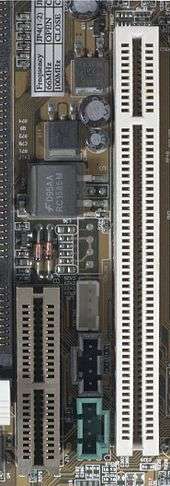Audio/modem riser

The audio/modem riser, also known as an AMR , is a riser expansion slot found on the motherboards of some Pentium III, Pentium 4, Duron, and Athlon personal computers. It was designed by Intel to interface with chipsets and provide analog functionality, such as sound cards and modems, on an expansion card.[1]
Design goals
One of the design goals of Intel for AMR was to allow motherboard manufacturers a way to implement analog I/O (audio and modem functionality) on an expansion card for U.S. Federal Communications Commission (FCC) certification. Potential cost-savings could then be realized by reusing the card on multiple motherboards and skipping FCC certification for those motherboards.[2][3]
Technology
Physically, it has two rows of 23 pins, making 46 pins total.[4] Three drawbacks of AMR are that it eliminates one Peripheral Component Interconnect (PCI) slot, it is not plug and play, and it does not allow for hardware accelerated cards (only software-based).[1]
Technologically, it has been superseded by the Advanced Communications Riser (ACR) and Intel's own Communications and Networking Riser (CNR). However, riser technologies in general never really took off. Modems generally remained as PCI cards while audio and network interfaces were integrated on to motherboards.
See also
- Advanced Communications Riser (ACR)
- Communications and Networking Riser (CNR)
- GeoPort
- Mobile Daughter Card
References
- 1 2 "Definition of riser card". PC Magazine. Retrieved May 2, 2016.
- ↑ "AMR". Webopedia. Retrieved May 2, 2016.
- ↑ "AMR (Audio/Modem Riser or AMR slot)". Whatis.com. February 2011. Retrieved May 2, 2016.
- ↑ "Audio Modem Riser (AMR)". Techopedia. Retrieved May 2, 2016.